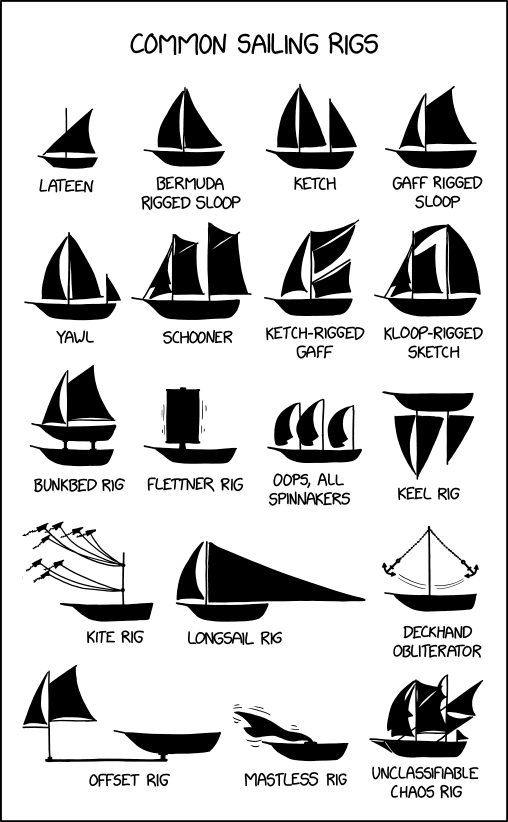Main Page
Welcome to the explain xkcd wiki!
We have an explanation for all 3202 xkcd comics, and only 60 (1.9%) are incomplete. Help us finish them!
Latest comic
| Sailing Rigs |
 Title text: I wanted to make the world's fastest yawl, so I made the aft sail bigger, but apparently that means it's not a yawl anymore! It's a real ketch-22. |
Explanation
This comic shows the side profiles of a variety of different sailing boat/ship rigs, not all of which are real.
| Type | Image | Real? | Description | Explanation |
|---|---|---|---|---|
| Lateen | 
|
Yes | A single triangular sail. | The triangular sail was affixed to a long yard or crossbar, mounted at its middle to the top of the mast and angled to extend aft far above the mast and forward down nearly to the deck. The sail, its free corner secured near the stern, was capable of taking the wind on either side, and, by enabling the vessel to tack into the wind, the lateen immensely increased the potential of the sailing ship. |
| Bermuda rigged sloop | 
|
Yes | A front and rear triangular sail share a mast. | Sloop |
| Ketch | 
|
Yes | A sailboat with two masts, where the main mast is taller than the mizzen (or aft mast), and the mizzen is forward of the rudder post | Similar to a Yawl |
| Gaff rigged sloop | 
|
Yes | A front triangular sail shares mast with rear quadrilateral sail. | A sloop is a sailboat with one mast, typically with two sails mounted on the mast, one ahead and one behind. A gaff Rig is a sailing rig where one sail is four-sided and controlled by a spar (the gaff) at its top, which is hoisted at an angle to the mast. |
| Yawl | 
|
Yes | Two triangular sails share a front mast, and a much smaller aft mast holds a small aft sail. | A Yawl is sailboat with two masts, where the main mast has two sails (One in front of the mast and one behind, known as fore-and-aft rigging, and the mizzen mast is mounted aft of the rudder post, leading the mizzen sail to typically be small. Similar to a Ketch. |
| Schooner | 
|
Yes | A sailboat with two or more masts, where all have fore-and-aft rigging, and where the foremast is typically smaller than the main mast | |
| Ketch-rigged gaff | 
|
No | The first fictional rig. Resembles a gaff, with the aft sail reduced and two triangular sails mounted above. The resulting shape resembles a vertical ketch. | |
| Kloop-rigged sketch | 
|
No | Four or five sails mounted in a nonsensical configuration, with elements from the schooner, ketch, and gaff | A mixture of the names of ketch and sloop, poking fun at the unfamiliar and odd-sounding names of some rigs. Adding to the absurdity, the kloop-rigged sketch is neither a sloop nor a ketch. However it is technically a sketch, as "sketch" can mean "drawing" |
| Bunkbed rig | 
|
No | A gaff-rigged sloop mounted on top of a second hull. | The name refers to a bunkbed, where a bed is mounted directly above another, and applies this idea to a ship, mounting a hull directly above another. While boats with multiple hulls do exist, these are always mounted side-by-side to guarentee stability. Mounting a hull above another would be a terrible idea, as the upper hull would be ineffective when raised above the water, the lower hull might become submerged and sink, and such a tall boat would be unstable causing it to fall over. The comic is funny due to this absurdity, due to boat's obivously extreme design being so far outside what someone would expect a boat to look like |
| Flettner rig | 
|
Yes, though not typically called a rig | The rectangular outline of a cylinder with motion lines around it, indicating a Flettner rotor | A Flettner rotor is a right circular cylinder with disc end plates which is spun along its long axis. As air passes across it the Magnus effect causes an aerodynamic lift force to be generated in the direction perpendicular to both the long axis and the direction of airflow. In a rotor ship, the rotors stand vertically and lift is generated at right angles to the wind, to drive the ship forwards.
Flettner rotors were previously mentioned in 3119 |
| Oops, all spinnakers | 
|
No | Three masts each with a sail billowing in front | A spinnaker is a real type of sail, where a boat is propelled by a large sail directly pulled by the wind, similar in principle to a parachute. However, "Oops, all spinnakers" is not real, as spinnakers are only practical for smaller craft, and if multiple spinnakers are mounted in a row the earlier ones may disrupt the airflow to the later ones[citation needed]. It does not appear that there are any real boats propelled by more than one spinnaker.[citation needed]
The name of the rig is a reference to the Cap'n Crunch cereal type that became a meme, Oops! All Berries, which has also been referenced in 2256 and 2719. |
| Keel rig | 
|
No | Three sails in a ketch arrangement, but mounted to the keel, which would typically put the sails underwater. | The book Heaven, by Ian Stewart and Jack Cohen, features an aquatic protagonist who is introduced as sailing a surface-craft with underwater-'sails' (and above-water 'keel'), due to the switched nature of his usual environment. |
| Kite rig | 
|
Kind of | All sails are replaced by two groups of kites, each tied to the mast with their own independent line. | A kite rig is a real thing, where a kite is deployed from a boat or ship to catch the wind and pull the vessel along. This rigging is used in various types of vessel, most commonly kite surfing, but occasionally other vessels too, up to trials with cargo ships. However, the real kite riggings typically use one large kite optimised for catching the wind, rather than many small kites optimised for flying (as depicted) which would likely get tangled and not pull much on the ship. |
| Longsail rig | 
|
No | A bermuda rigged sloop with the aft sail extending ~5 times as far back, well beyond the end of the hull. | While not technically impossible, such a long sail would likely be suceptiple to damage from the wind, as well as potentially making it hard to control the boat. This design could be a reference to "long-tail bikes", a type of cargo bicycle useful for hauling heavy or voluminous charges at the cost of higher weight and reduced manoeuvrability. |
| Deckhand obliterator | 
|
No | All sails replaced by an anchor that swings around the mast on a chain, similar to tetherball. | Any deckhands (crew) on the deck could be knocked off or fatally hurt if the anchor passes through their space. |
| Offset rig | 
|
No | Gaff rigged sloop sails are mounted on a mast that is offset (forward) from the hull via an underwater extension of the keel. | The extreme mechanical advantage of the sail, potentially combined with the uneven weight, would make this rigging hard if not impossible to control. There are in fact sail configurations called offset rigs but they aren't like the one shown here. |
| Mastless rig | 
|
Kind of | A single sail is directly to the hull of the boat, without any mast holding it in the wind. | As depicted the sail would provide little to no useful propulsion, as it would not be high enough to effective catch the wind. However ships do exist without sails, such as ships not powered by wind[citation needed], or more rarely inflatable sails (e.g. this concept), which use air rather than a mast for rigidity. While not intentional, it is conceivable that the drawing depicts an inflatable sail in its deflated state. |
| Unclassifiable chaos rig | 
|
Arguably | Includes elements of the schooner, yawl, lateen, and possibly others. | While this specific rig is almost certainly fictional, there are many ways to rig a ship, some of which are difficult to classify. |
The title text is a pun on the term Catch-22, which is a term (taken from the novel of the same name) for a situation where success is impossible because it requires meeting contradictory conditions. For example, in the novel, the term was used by military pilots who qualified to be released from combat duty, but were ordered to fly additional missions, and were told that disobeying those orders was grounds to have their releases revoked, which would require them to fly additional missions anyway.
Per the main panel, a ketch is similar to a yawl but has a larger aft sail, so increasing the aft sail of a yawl effectively turns the yawl into a ketch, effectively making it impossible to build a faster yawl. However this is not technically true, as the distinction between a yawl and ketch is based on whether the aft sail is mounted forward or aft of the rudder post, although a yawl with a large aft sail may be difficult to control.[actual citation needed]
Transcript
[The comic contains views from the side of boats, each with a different sailing rig. All boats are oriented to the left of the comic.]
- Lateen [a single triangular sail]
- Bermuda rigged sloop [a front and rear triangular sail share a mast]
- Ketch [two triangular sails as above, with an additional triangular sail on a second rear mast]
- Gaff rigged sloop [front triangular sail shares mast with rear quadrilateral sail]
- Yawl [two triangular sails share front mast and a much smaller aft mast holds a small aft]
- Schooner [two triangular front sails share foreward mast with quadrilateral center sail. An aft mast supports a quadrilateral aft sail]
- Ketch-rigged gaff [Resembles a gaff, with the aft sail reduced and two triangular sails mounted above. The resulting shape resembles a vertical ketch]
- Kloop-rigged sketch: [Includes elements of ketch and sloop]
- Bunkbed rig [A gaff-rigged sloop is mounted on top of a second hull]
- Flettner rig [The rectangular outline of a cylinder with motion lines around it]
- Oops, all spinnakers [three masts each with a sail only attached to the top]
- Keel rig [three sails in a ketch arrangement, but mounted to the keel]
- Kite rig [all sails are replaced by two groups of kites, each tied to the mast with an independent line]
- Longsail rig [bermuda rigged sloop with the aft sail extending ~5 times as far back, well beyond the end of the hull]
- Deckhand obliterator [all sails replaced by an anchor that swings around the mast on a chain, similar to tetherball]
- Offset rig [gaff rigged sloop sails are mounted on a mast that is offset (forward) from the hull via an underwater extension of the keel]
- Mastless rig [a single sail is attached where the mast would normally be mounted, flapping around freely]
- Unclassifiable chaos rig [includes elements of the schooner, yawl, lateen, and possibly others]
New here?
Last 7 days (Top 10) |
|||||||||||||||||||||||||||||||||||||||||||||||||||||||
|
You can read a brief introduction about this wiki at explain xkcd. Feel free to create an account and contribute to the wiki! We need explanations for xkcd comics, characters, What If? articles, and everything in between. If it is referenced in an xkcd comic, it should be here.
- If you're new to wiki editing, see the explain xkcd:Editor FAQ for a specific guidance to this wiki and the more general help on how to edit wiki pages. There's also a handy wikicode cheatsheet.
- Discussion about the wiki itself happens at the Community portal.
- You can browse the comics from the list of all comics or by navigating the category tree at Category:Comics.
- The incomplete explanations are listed here. Feel free to help out by expanding them!
Rules
Don't be a jerk!
There are a lot of comics that don't have set-in-stone explanations; feel free to put multiple interpretations in the wiki page for each comic.
If you want to talk about a specific comic, use its discussion page.
Please only submit material directly related to xkcd and, of course, only submit material that can legally be posted and freely edited. Off-topic or other inappropriate content is subject to removal or modification at admin discretion, and users who repeatedly post such content will be blocked.
If you need assistance from an admin, post a message to the Admin requests board.
